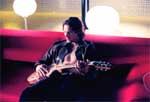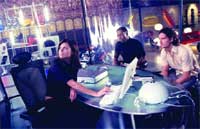
Fastlane features high-intensity color - the producers call it "hyper-realism."
|
BURBANK - Flashbacks, slo-mo, fast cuts, split screens, subliminal cuts and hyper-reality. These are just some of the terms that could be used when describing the editing style of Fastlane, the slick, freshman Fox show and brainchild of music video and Charlie's Angles director McG and veteran writer/producer (Prophet, Lois and Clark) John McNamara.
"McG came to me in October of 2001 with a rough but very compelling idea about a stylish cop show like Miami Vice," says McNamara, Fastlane's co-executive producer.
He says Warner Bros. gave them the money and time, 24 shooting days, to make an excellent first episode. "We achieved everything we wanted to achieve in the pilot," continues McNamara. "The challenge is how to replicate something as big and colorful and fun on a weekly basis. So far McG and I are really pleased with the results."

The show is offlined on Media Composers and onlined by Modern VideoFilm on Symphony.
|
I tell associate producer Ben Kunde that the Fastlane pilot warped across my eyeballs like a live-action comic book on steroids. He laughs and acknowledges the show is an unabashed homage to The Fast and the Furious.
It's inspired by editorially-driven shows says pilot/series editor Norman Buckley, adding, "McG is very clear what he wants to achieve. It's about evoking primary emotions and not overdoing it. He gives me enormous freedom to try things and see what happens."
Because of all the action photography, mounting the show, says Kunde, is massive. "It's like making a 43-minute feature film every week." The principal shooting schedule is eight days per show, and for almost every episode they shoot two 12-hour days of second unit photography.
First unit DP Nathan Hope and second unit DP Cort Fey shoot a variety of super 35mm 3-perf and 4-perf Kodak stocks. Generally, Kunde says, production likes to shoot on 3-perf to save money, but the show does a lot of motion effects and in-camera speed changes, shooting many scenes at 120 fps, so they need the 4-perf.
"One stylistic hallmark of the show is starting in slow motion and then ramping up to full motion or faster than full motion," describes Kunde. They also composite up to four split screens in a scene providing "a more interesting way for exposition to take place."
Fastlane chose a lighting style that creates high-intensity color, an approach they call "hyper-realism." Defined in the pilot episode, director McG and DP Ramsey Nichol lit everything on the flat side of the lighting spectrum. "When one spot isn't hotter than another," explains Kunde, "you can crush your blacks and clips, and you can clip your whites and really push the saturation." In production meetings, they apply the hyper-realism principle to everything from story to props to wardrobe and production design.
THE EDITING
At Modern VideoFilm (www.mvf.tv) in Burbank, Kunde transfers up to 90,000 feet of footage per episode on the Rank Cintel Ursa Gold to Digi Beta at 30fps. Three full-time editors - Buckley, Matt Ramsey and Scott Wallace - plus three assistant editors, cut away in a trailer on the Warner Bros. lot, editing down on average 20 hours of footage for each Fastlane episode.
Digital Symphony (www.digitalsymphony. net) provided them with three Avid Media Composers and an Avid Media Share system. Assistant editors arrive at the crack of dawn to digitize DVCAM dallies into the 216 GB hard drive which lets them hold footage for three to four episodes at a time. The editors build the shows offline as 24fps project files. Those are directly ported to the Avid Symphony at Modern for online editing.
"You get the actual timeline," says Modern's Symphony editor, Cliff Armstrong, "which makes it seamless to go from box to box. The editors do a lot of effects, layered things, split screens." Armstrong decomposes the project, lines up the source reels involved and recaptures just the footage needed at full Digi Beta resolution. "I've had up to 900 clips to re-digitize on a single episode."
The reason Fastlane does its online with the Symphony, says Kunde, is because of the many motion-ramping effects and split screens the show uses. "If we were doing that in a linear bay, those numbers from the offline system never really translate correctly. We consider it the only way we can get the show done in a timely fashion."
Stargate Digital (www.stargatefilms.com) provides the flashy visual effects for Fastlane. They do a number of shots on virtually every episode ranging from routine roto work, wire removal and explosion enhancements to ultra-sophisticated, complex micro to macro tracking shots that combines CG with live action plates.
"The whole vibe of the show is to suspend the moment, to heighten the reality," says Doug Ludwing, Stargate/Fastlane visual effects supervisor. "There are dramatic speed ramps, freezing a bullet in some incredible way or unique POVs that go from wide action shots into a microscopic world." Stargate uses Alias|Wavefront Maya for their CG work and Adobe After Effects for compositing.
Even though they post on Digi Beta, they still deliver both a16-by-9 and 3-by-4 aspect ratio master to Warner Bros. "From the last day of dailies we deliver a finished show to the network three-and-a-half to four weeks later," explains Kunde.